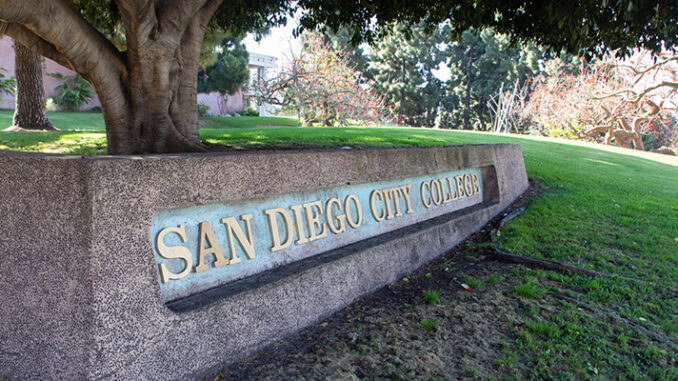
Enrollment at California Community Colleges fell even more last fall than an already shocking national average. Campus leaders hope to stem further declines as the COVID-19 pandemic continues.
by Sara Weissman
The California Community College system had a 12 percent enrollment decline from fall 2019 to fall 2020 — a loss of 186,688 students — a staggering figure for the largest college system in the country and a likely harbinger of the demographic and fiscal challenges that lie ahead for the sector nationally.
The downward trend is occurring at community colleges across the country — the National Student Clearinghouse Research Center recently reported a 9.5 percent decline at community colleges nationwide — and is being compounded by the acute socioeconomic effects of the pandemic on students.
With more than two million full- and part-time students in the California system, the enrollment drop was not surprising to those familiar with demographic and economic trends community colleges are currently facing.
“I think as the lowest per-student funded institutions serving the most diverse, lowest-income Californians with the least amount of financial aid for nontuition costs in a time when we have national historic inequality, it’s no surprise,” said Larry Galizio, president and CEO of the Community College League of California, an association for community college leaders in the state.
Michele Siqueiros, president of the California-based Campaign for College Opportunity, pointed out that community colleges serve students most affected by the pandemic and its accompanying economic downturn.
“Our community colleges are where students who are most vulnerable really find their opportunity to go to college. We know that low-income students and students of color have been hardest hit by this pandemic, both in terms of actually contracting COVID and dying from COVID as well as actually losing jobs,” she said. “When our communities are disproportionately affected, we know that those students who are bearing the brunt are students who could be enrolling in community college and could be benefiting from a community college education, but now they have to work, they have to help their families or they’re dealing with the effects of the pandemic on their families.”
News of the 12 percent decrease in enrollment was presented at a March meeting of the Board of Governors of the California Community Colleges. A recent data analysis by EdSource also reported that headcount, the total number of students in any class (rather than the total number enrolled based on course credit), plunged by 16.8 percent, a loss of 260,000 students systemwide.
The EdSource analysis pointed to the College of the Siskiyous, which is north of San Francisco, as having the highest percentage decrease, a 56 percent decline from 3,095 to 1,353 students. Santa Ana College, which is south of Los Angeles, lost the most students, 11,971, a 34 percent drop, according to the analysis.
“All of us were forced to go online, except for essential programs, which means all of us were competing with each other,” said Char Perlas, acting superintendent and president of College of the Siskiyous.
She saw a particularly steep drop in students taking noncredit courses such as swimming or dance, which can be harder to offer online. The noncredit student population fell from 1,403 to 224 students, an 84 percent decrease.
Paul Feist, vice chancellor for communication and marketing for the college system, noted that four colleges have yet to report their fall 2020 head counts. He could not say when those numbers would be available but didn’t expect the final tally to significantly alter the current picture.
“I’m not trying to minimize the enrollment decline that we have, because our students have obviously faced huge challenges during the pandemic,” Feist said.
An impact survey of 49,463 California Community College students in May and June 2020, conducted by the system in partnership with the Research and Planning Group for California Community Colleges, indicated that those challenges were serious. Forty-one percent of students faced a change in employment during the pandemic. About 19 percent had their work hours reduced, and 22 percent were fired or furloughed. More than half of students reported their income decreased. About 57 percent faced basic needs insecurity, a group that was disproportionately made up of students of color.
Meanwhile, more than 40 percent were responsible for caring for a family member while in school, the survey found.
“A lot of our students are parents, and they have to do their best impersonation of a kindergarten teacher or a second-grade teacher because they have to get their young ones to school in the home setting,” Feist said.
The deepest enrollment drops were among older adults, often students who are parents, and underrepresented students. Latino student enrollment fell 12 percent, Black student enrollment dropped 15 percent and Indigenous student enrollment was the hardest hit at 18 percent, according to the survey.
At Compton College, enrollment dropped 21 percent last fall and 27 percent this spring. Keith Curry, president and CEO of the college, expects the pandemic will have a “lingering” impact on enrollment for the next five to 10 years.
“People assume that students are going to enroll just because the door is open,” Curry said. “But our community has been hardest hit.”
The Compton College #RealCollege survey report — conducted by the Hope Center for College, Community and Justice in 2019 — found that 56 percent of Compton College students faced food insecurity within 30 days of the survey. About 63 percent experienced housing insecurity, and 23 percent had been homeless that year. More than 20 percent of residents in the city of Compton have incomes that fall below the poverty line, according to 2019 U.S. Census Bureau data.
In Compton, Lynwood and Paramount, three cities served by the college, one in six people contracted COVID-19, according to Los Angeles County Department of Public Health data.
“Our community has been devastated by COVID-19,” Curry said. “When you talk about enrollment decline, health and safety is No. 1. They’re not thinking about registering for classes.”
Deborah Santiago, CEO of Excelencia in Education, an organization that promotes college attendance and completion by Latino students, worries California will enroll fewer Latino students going forward, even as their population continues to grow in the state, because of residual effects of the pandemic.
Out of the 175 Hispanic-serving institutions in the state, 95 of them are community colleges.
“We’ve lost a great deal of those gains,” she said. “It’s up to us to make sure that … we reach out to them more overtly and we hold on to them.”
Although community college enrollment is plummeting nationwide, the California system faces unique challenges, said Galizio, the president of the state community college league. He described California as a state of both “exceptional diversity and wealth inequality.”
“We have some of the wealthiest people in the country, if not the world,” he said. “At the same time, we have a large group of people whose lives are very precarious or a low socioeconomic status, and so the wealth gap and the ability for a lot of Californians to absorb a lot of this pandemic and recession is very challenging.”
Galizio noted that the high cost of living in California puts additional financial stress on community college students. They may only spend about $552 per semester for a full course load, but their total cost of going to college also includes paying rent and student fees, buying course materials, paying for transportation, and juggling other related costs. Those cumulative expenses are much higher and difficult to afford, especially during a pandemic.
The institutions themselves also serve very different communities, he added, so their efforts to increase enrollment vary.
“In terms of enrollment strategy, we are locally based, locally focused institutions, so what works in rural-serving Shasta Community College is different from what works at Los Angeles Community College District,” Galizio said.
Still, he has found that California Community Colleges are increasingly reaching out to students via phone call and text message — with an emphasis on a “personal touch” — to inform them about support services available, such as emergency aid or academic counseling, as a strategy to keep students from stopping out next fall.
Perlas, of College of the Siskiyous, said in addition to doing outreach, the college is starting new initiatives to attract prospective students this fall, including a freshman study abroad program and a new partnership that allows Mendocino College students to participate in its paramedic programs and earn a certificate or associate’s degree.
Santiago noted that these targeted recruitment efforts are new for community colleges, unlike four-year institutions and for-profit colleges that employ large marketing teams.
“The role of community colleges having to do outreach and actively compete has not been a big focus,” she said. “We don’t have a big marketing budget. Because we’re open-access institutions, the thought is, you accept those that come.”
This pivot feels like a “game changer” if it keeps students — particularly students of color — enrolled.
Feist, spokesperson for the chancellor’s office, emphasized that the system is focusing on retention. He expects enrollment numbers to climb as K-12 schools reopen and allow students who had to stay home with their children to return to college. Students hesitant about online learning because they lack devices or reliable broadband service will also be better served by more campuses reopening as more people are vaccinated, he said.
“It’s not just enrollment for enrollment’s sake,” Feist said. “It’s getting the students who have stopped out from our colleges, the students who have graduated from high school and took a year off and the older re-entry students … reaching out to a lot of different populations and seeing what their needs are. It’s going to be vital to the recovery for the state of California to get these folks back to our colleges.”
Feist noted that community college leaders have learned more about the obstacles their students face because of the COVID-19 crisis. This “heightened empathy for students” will outlive the pandemic and continue to inform college administrators’ choices, he said.
Siqueiros said the huge loss of students should also be a national wake-up call for community college leaders and lawmakers to enact policies that address long-standing disparities, such as doubling the federal Pell Grant for low-income students and expanding emergency financial aid so community college students have the short- and long-term support they need.
California is a “bellwether not only for what is happening for our most vulnerable students but also for the response,” she said. “I think the data is really sobering, but what we do in response to that data is the most critical now.”
.
(Note: This article was revised to reflect differences in headcount and overall enrollment, two metrics used to measure the number of students enrolled at colleges within the California Community College system. Both metrics indicated significant declines in enrollment in Fall 2020. The 12 percent figure cited in the article referred to overall enrollment, which is calculated based on students’ course credit loads. The data was provided by the office of the college system’s chancellor and presented in a memo to its Board of Governors. The memo also cited a 15-16 percent decline in headcount, which is consistent with an analysis conducted by EdSource based on the total number of students taking any class.)
Sara Weissman covers nontraditional students and the institutions that serve them for Inside Higher Ed. Before joining the team in 2021, she was a staff writer for Diverse: Issues in Higher Education and the editor of New Voices Magazine. She earned her master’s degree at Columbia University Graduate School of Journalism.



